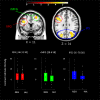An fMRI study on the neural correlates of social conformity to a sexual minority
- PMID: 30886162
- PMCID: PMC6423124
- DOI: 10.1038/s41598-019-40447-3
An fMRI study on the neural correlates of social conformity to a sexual minority
Abstract
Social conformity refers to the tendency to align one's own behaviors, beliefs and values to those of others. Little is known about social influence coming from a minority group. To test whether social pressure from sexual minorities triggers avoidance-motivated behaviors, we explored how being influenced by the preferences of gay peers modifies the behavioral and neural reactivity of individuals defined as in- vs. out- groups on the basis of sexual orientation. To this aim, we combined fMRI with a social conformity paradigm in which heterosexual and gay/bisexual (hereafter non-exclusively heterosexual, NEH) individuals provided with male body attractiveness ratings by a fictitious group of gay students may or may not alter their previous rating and may or may not conform to the mean. Behaviorally, conformity to the minority preference was found in in-group NEH more than in out-group heterosexuals. Analysis of BOLD signal showed that social pressure brought about increased brain activity in frontal and parietal regions associated with the detection of social conflict. These results show that members of a sexual majority group display a smaller level of conformity when a sexual minority group exerts social influence. However, the neural correlates of this modulation are yet to be clarified.
Conflict of interest statement
The authors declare no competing interests.
Figures



Similar articles
-
Depression and Sexual Orientation During Young Adulthood: Diversity Among Sexual Minority Subgroups and the Role of Gender Nonconformity.Arch Sex Behav. 2016 Apr;45(3):697-711. doi: 10.1007/s10508-015-0515-3. Epub 2015 Apr 14. Arch Sex Behav. 2016. PMID: 25868403
-
Sexual Identity, Sex of Sexual Contacts, and Health-Related Behaviors Among Students in Grades 9-12 - United States and Selected Sites, 2015.MMWR Surveill Summ. 2016 Aug 12;65(9):1-202. doi: 10.15585/mmwr.ss6509a1. MMWR Surveill Summ. 2016. PMID: 27513843
-
Sociodemographic Characteristics and Health Outcomes Among Lesbian, Gay, and Bisexual U.S. Adults Using Healthy People 2020 Leading Health Indicators.LGBT Health. 2017 Aug;4(4):283-294. doi: 10.1089/lgbt.2016.0087. Epub 2017 Jul 20. LGBT Health. 2017. PMID: 28727950 Free PMC article.
-
Lay Conceptions of Sexual Minority Groups.Arch Sex Behav. 2016 Apr;45(3):635-50. doi: 10.1007/s10508-015-0655-5. Epub 2015 Nov 23. Arch Sex Behav. 2016. PMID: 26597649 Clinical Trial.
-
Who Has a Better Auditory Gaydar? Sexual Orientation Categorization by Heterosexual and Lesbian, Gay, and Bisexual People.J Homosex. 2023 Apr 16;70(5):876-899. doi: 10.1080/00918369.2021.2004796. Epub 2022 Jan 10. J Homosex. 2023. PMID: 35007490
Cited by
-
Neurophysiological correlates of interpersonal discrepancy and social adjustment in an interactive decision-making task in dyads.Front Psychol. 2024 Feb 14;15:1272841. doi: 10.3389/fpsyg.2024.1272841. eCollection 2024. Front Psychol. 2024. PMID: 38420174 Free PMC article.
References
-
- Asch SE. Studies of independence and conformity: I. A minority of one against a unanimous majority. Psychological Monographs: General and Applied. 1956;70:1–70. doi: 10.1037/h0093718. - DOI
-
- Bond R, Smith PB. Culture and conformity: A meta-analysis of studies using Asch's (1952b, 1956) line judgment task. Psychological Bulletin. 1996;119:111. doi: 10.1037/0033-2909.119.1.111. - DOI
Publication types
MeSH terms
LinkOut - more resources
Full Text Sources
Medical

